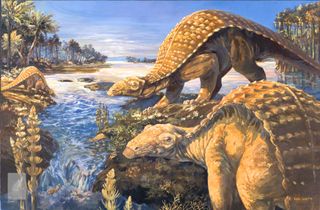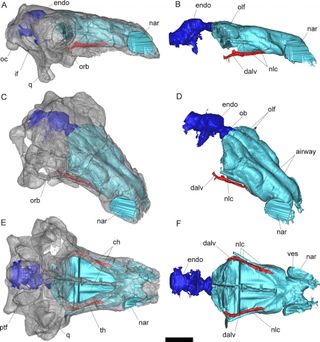Dino Senses: Ankylosaurus Cousin Had a Super Sniffer

The armored cousin of the Ankylosaurus dinosaur didn't have a football-size club on its tail, but it did have a super sense of smell, said scientists who examined its skull.
The Cretaceous-age Pawpawsaurus campbelli walked on all fours and lived in ancient Texas about 100 million years ago, the researchers said. It was an earlier version, so to speak, of the heavily armored Ankylosaurus, which lived about 35 million years later, they said.
But even without an impressive tail club, P. campbelli wasn't totally defenseless. It sported armored plates on its back and eyelids. A computerized tomography (CT) scan of its braincase also suggests that the dinosaur had an excellent sense of smell for finding prey and avoiding predators. [Image Gallery: 25 Amazing Ancient Beasts]
"CT imaging has allowed us to delve into the intricacies of the brains of extinct animals, especially dinosaurs, to unlock secrets of their ways of life," study co-author Louis Jacobs, a vertebrate paleontologist at Southern Methodist University in Dallas, Texas, said in a statement.
P. campbelli could have outsniffed other primitive dinosaur predators, including Ceratosaurus, a bipedal, meat-eating dinosaur with blade-like teeth and a horn on its snoutthat lived during the Jurassic period, the researchers said.
CT scans suggest that P. campbelli's sense of smell — calculated by comparing the size of the brain's olfactory bulb to the cerebral hemisphere — is somewhat less powerful than that of Ankylosaurus, said study lead researcher Ariana Paulina-Carabajal, a vertebrate paleontologist at the Biodiversity and Environment Research Institute (CONICET-INIBIOMA) in San Carlos de Bariloche, Argentina.
"Although both [P. campbelli and Ankylosaurus] have high ratios when compared with most carnivorous dinosaurs," she said, "they are exceeded only by carcharodontosaurids and tyrannosaurids."
Sign up for the Live Science daily newsletter now
Get the world’s most fascinating discoveries delivered straight to your inbox.
Ankylosaur evolution
Perhaps this super sniffer gave P. campbelli an edge, despite its lack of some of the other physical features that are thought to be important for Ankylosaurus' survival.
"Pawpawsaurus in particular, and the group it belonged to — Nodosauridae — had no flocculus, a structure of the brain involved with motor skills — no club tail, and a reduced nasal cavity and portion of the inner ear when compared with the other family of Ankylosaurus," Paulina-Carabajal said. "But its sense of smell was very important, as it probably relied on that to look for food, find mates and avoid or flee predators."

Moreover, the CT scans — the first ever taken of a P. campbelli skull — show that the dinosaur had a large nasal cavity that likely helped it to vocalize.
The oversized nasal cavity "may have helped Pawpawsaurus bellow out a lower range of vocalizations, improved its sense of smell and cooled the inflow of air to regulate the temperature of blood flowing into the brain," Paulina-Carabajal said.
The study was published online March 23 in the journal PLOS ONE.
Follow Laura Geggel on Twitter @LauraGeggel. Follow Live Science @livescience, Facebook & Google+. Original article on Live Science.

Laura is the archaeology and Life's Little Mysteries editor at Live Science. She also reports on general science, including paleontology. Her work has appeared in The New York Times, Scholastic, Popular Science and Spectrum, a site on autism research. She has won multiple awards from the Society of Professional Journalists and the Washington Newspaper Publishers Association for her reporting at a weekly newspaper near Seattle. Laura holds a bachelor's degree in English literature and psychology from Washington University in St. Louis and a master's degree in science writing from NYU.
Most Popular

